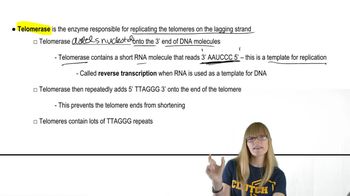In 1994, telomerase activity was discovered in human cancer cell lines. Although telomerase is not active in most human adult cells, all cells do contain the genes for telomerase proteins and telomerase RNA. Since inappropriate activation of telomerase may contribute to cancer, why do you think the genes coding for this enzyme have been maintained in the human genome throughout evolution? Are there any types of human body cells where telomerase activation would be advantageous or even necessary? Explain.
Table of contents
- 1. Introduction to Genetics51m
- 2. Mendel's Laws of Inheritance3h 37m
- 3. Extensions to Mendelian Inheritance2h 41m
- 4. Genetic Mapping and Linkage2h 28m
- 5. Genetics of Bacteria and Viruses1h 21m
- 6. Chromosomal Variation1h 48m
- 7. DNA and Chromosome Structure56m
- 8. DNA Replication1h 10m
- 9. Mitosis and Meiosis1h 34m
- 10. Transcription1h 0m
- 11. Translation58m
- 12. Gene Regulation in Prokaryotes1h 19m
- 13. Gene Regulation in Eukaryotes44m
- 14. Genetic Control of Development44m
- 15. Genomes and Genomics1h 50m
- 16. Transposable Elements47m
- 17. Mutation, Repair, and Recombination1h 6m
- 18. Molecular Genetic Tools19m
- 19. Cancer Genetics29m
- 20. Quantitative Genetics1h 26m
- 21. Population Genetics50m
- 22. Evolutionary Genetics29m
8. DNA Replication
Telomeres and Telomerase
Problem 26a
Textbook Question
Telomeres are found at the ends of eukaryotic chromosomes. What is the sequence composition of telomeres?
 Verified step by step guidance
Verified step by step guidance1
Understand that telomeres are repetitive DNA sequences located at the ends of eukaryotic chromosomes, serving to protect the chromosome from degradation and fusion with other chromosomes.
Learn that the sequence composition of telomeres is highly conserved across many eukaryotic organisms. In humans and other vertebrates, the telomeric sequence is typically a repeated hexanucleotide motif.
Recognize that the specific sequence in humans is represented as , where 'n' indicates the number of repeats.
Understand that telomerase, an enzyme, is responsible for adding these repetitive sequences to the ends of chromosomes, ensuring their maintenance and stability during cell division.
Explore how telomeres play a critical role in cellular aging and genome stability, as their shortening over time is associated with aging and certain diseases.
 Verified video answer for a similar problem:
Verified video answer for a similar problem:This video solution was recommended by our tutors as helpful for the problem above
Video duration:
2mPlay a video:
Was this helpful?
Key Concepts
Here are the essential concepts you must grasp in order to answer the question correctly.
Telomere Structure
Telomeres are repetitive nucleotide sequences located at the ends of eukaryotic chromosomes. They consist primarily of tandem repeats of a specific DNA sequence, typically rich in guanine (G) and cytosine (C), which helps protect the chromosome from degradation and prevents the loss of essential genetic information during DNA replication.
Recommended video:
Guided course

Telomeres and Telomerase
Function of Telomeres
The primary function of telomeres is to maintain chromosomal stability by preventing the ends of chromosomes from fusing with each other or being recognized as damaged DNA. As cells divide, telomeres shorten, which is associated with cellular aging and limits the number of times a cell can divide, a phenomenon known as the Hayflick limit.
Recommended video:
Guided course

Telomeres and Telomerase
Telomerase Enzyme
Telomerase is an enzyme that adds nucleotide sequences to the ends of telomeres, counteracting their shortening during cell division. This enzyme is particularly active in stem cells and cancer cells, allowing them to maintain telomere length and proliferate indefinitely, which is a key factor in tumorigenesis.
Recommended video:
Guided course

Telomeres and Telomerase

 8:38m
8:38mWatch next
Master Telomeres and Telomerase with a bite sized video explanation from Kylia
Start learningRelated Videos
Related Practice
Textbook Question
628
views
